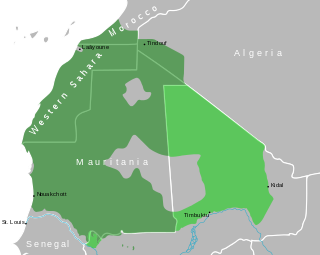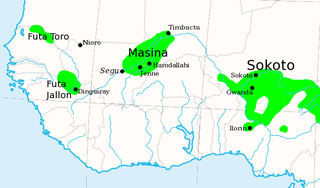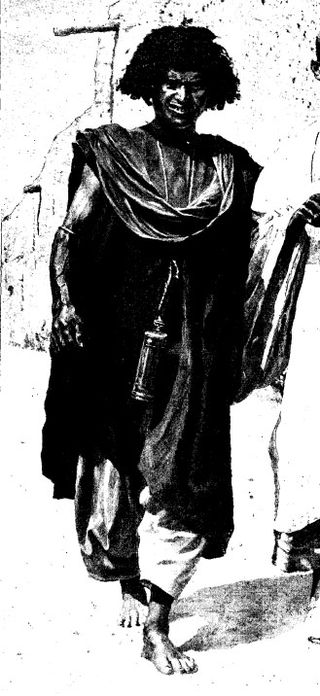A marabout is a descendant of the Prophet Muhammad and a Muslim religious leader and teacher who historically had the function of a chaplain serving as a part of an Islamic army, notably in North Africa and the Sahara, in West Africa, and (historically) in the Maghreb. The marabout is often a scholar of the Qur'an, or religious teacher. Others may be wandering holy men who survive on alms, Sufi Murshids ("Guides"), or leaders of religious communities.

Beni Ḥassan is a Bedouin Arab tribe which inhabits Western Sahara, Mauritania, Morocco and Algeria. It is one of the four sub-tribes of the Banu Maqil who emigrated in the 11th century from South Arabia to the Maghreb with the Banu Hilal and Banu Sulaym Arab tribes. In the 13th century, they took the Sanhaja territories in the southwest of the Sahara. In Morocco, they first settled, alongside their Maqil relatives, in the area between Tadla and the Moulouya River. The Sous Almohad governor called upon them for help against a rebellion in the Sous, and they resettled in and around that region. They later moved to what is today Mauritania, and from the 16th century onwards, they managed to push back all black peoples southwards to the Senegal Valley river. The Beni Hassan and other warrior Arab tribes dominated the Sanhaja Berber tribes of the area after the Char Bouba war of the 17th century. As a result, Arabs became the dominant ethnic group in Western Sahara and Mauretania. The Bani Hassan dialect of Arabic became used in the region and is still spoken, in the form of Hassaniya Arabic. The hierarchy established by the Beni Hassan tribe gave Mauritania much of its sociological character. That ideology has led to oppression, discrimination and even enslavement of other groups in Mauritania.

The Tijjani order is a Sufi order of Sunni Islam named after Ahmad al-Tijani. It originated in the Algeria but now more widespread in Maghreb, West Africa, particularly in Senegal, Gambia, Mauritania, Mali, Guinea, Niger, Chad, Ghana, Northern and Southwestern Nigeria and some parts of Sudan. The Tijāniyyah order is also present in the states of Kerala, Tamil Nadu and Karnataka in India. Its adherents are called Tijānī. Tijānīs place great importance on culture and education and emphasize the individual adhesion of the disciple (murid). To become a member of the order, one must receive the Tijānī wird, or a sequence of holy phrases to be repeated twice daily, from a muqaddam, or representative of the order.

Hadji Oumarûl Foutiyou Tall, born in Futa Tooro, present-day Senegal, was a Senegalese Tijani sufi Toucouleur Islamic scholar and military commander who founded the short-lived Toucouleur Empire, which encompassed much of what is now Senegal, Mauritania, Guinea and Mali.

The Caliphate of Hamdullahi, commonly known as the Massina empire, was an early nineteenth-century Sunni Muslim caliphate in West Africa centered in the Inner Niger Delta of what is now the Mopti and Ségou Regions of Mali. It was founded by Seku Amadu in 1818 during the Fulani jihads after defeating the Bambara Empire and its allies at the Battle of Noukouma. By 1853, the empire had fallen into decline and was ultimately destroyed by Omar Saidou Tall of Toucouleur.

The Qadiriyya or the Qadiri order is a Sunni Sufi order (Tariqa) founded by Abdul Qadir Gilani, who was a Hanbali scholar from Gilan, Iran. The symbol of the order is the rose. A rose of green and white cloth, with a star in the middle, is traditionally worn in the cap of Qadiri dervishes. Robes of black felt are customarily worn as well. The names of God are prescribed as chants for repetition, or Dhikr, by initiates.
Sheikhu Ahmadu was the Fulbe founder of the Massina Empire in the Inner Niger Delta, now the Mopti Region of Mali. He ruled as Almami from 1818 until his death in 1845, also taking the title sisse al-Masini.
Amadu III of Masina, also known as Amadu Amadu was the third and last ruler of the theocratic Caliphate of Hamdullahi in the Inner Niger Delta, now the Mopti Region of Mali. He was elected as successor to his father, Amadu II of Masina, in 1853. Throughout most of his rule he was involved in conflict with the jihadist al-Hajj 'Umar Tall, who defeated and executed him on 16 May 1862.
The Wangara are a diaspora community of ethnic Soninke origin who served as specialized long-distance merchants throughout West Africa, particularly in Trans-Saharan trade. Originating from the Ghana Empire, over time the Wangara became integrated into numerous other communities and ethnic groups, particularly in Timbuktu, Agadez, Kano, Gao, Salaga, Kong, Bissa, Kankan, Fouta Jallon, Djenné as well as Bambouk, Bure, Lobi, and Bono goldfields and Borgu. They were practicing Muslims who helped spread the religion widely and served as clerics, political advisors, healers and marabouts, often following the Suwarian Tradition.

Ahmad al-Bakkai al-Kunti was a West African Islamic and political leader. He was one of the last principal spokesmen in precolonial Western Sudan for an accommodationist stance towards the threatening Christian European presence, and even provided protection to Heinrich Barth from an attempted kidnapping by the ruler of Massina, Amadu III. In a letter to the ruler, which was rather a fatwa he denied the former's right to have Barth arrested or killed and his belongings confiscated, as the Christian was neither a dhimmi nor an enemy of Islam, but the native of a friendly country, that is Great Britain. He went as far as to deny Ahmad Ahmad ibn Muhammad Lobbo the right to proclaim a jihad and called him "the ruler over a few huts at the outskirts of the Islamic world".

Islam is the main religion in Guinea, followed by an estimated 90% of the population as of 2022. "Most are Sunnis who follow the Maliki legal tradition and Qadiri and Tijani Sufi orders."
The Char Bouba war, also known as the Mauritanian Thirty Years' War or the Marabout War, took place between 1644 and 1674 in the tribal areas of what is today Mauritania and Western Sahara as well as in the Senegal river valley. It was fought between the Sanhadja Berber tribes and Muslim populations in the river valley, led by Lamtuna Imam Nasr ad-Din, on one hand; and the Maqil Arab immigrant tribes, foremost of which was the Beni Hassan, as well as the traditional aristocracies of the Wolof states on the other, supported by the French.

The Imamate of Futa Toro was a West African theocratic monarchy of the Fula-speaking people in the middle valley of the Senegal River, in the region known as Futa Toro. Following the trend of jihads in the late 17th century and early 18th century, the religious leader Sulayman Bal led a jihad in 1776. His successor, the expansionist Abdul Kader defeated the emirates of Trarza and Brakna and by his death in 1806, power became decentralized between a few elite families of Torodbes. Threatened by both the expansion of the Toucouleur Empire and the French in the mid-19th century, Futa Toro was eventually annexed in 1859. By the 1860s, the power of the Almamy became nominal and the state was further weakened when a cholera epidemic killed a quarter of its population in 1868.

The Kountas or Kuntas are described originally as Arabs, descendants of Uqba ibn Nafi. The Kunta tribe are also considered to have roots to Sidi Ahmed al-Bakkay, the founder, who died in the early 16th century. The Kunta originated in Qayrawan.
The University of Timbuktu is a collective term for the teaching associated with three mosques in the city of Timbuktu in what is now Mali: the mosques of Sankore, Djinguereber, and Sidi Yahya. It was an organized scholastic community that endured for many centuries during the medieval period. The university contributed to the modern understanding of Islamic and academic studies in West Africa during the medieval period and produced a number of scholars and manuscripts taught under the Maliki school of thought.
The Jakhanke -- also spelled Jahanka, Jahanke, Jahanque, Jahonque, Diakkanke, Diakhanga, Diakhango, Dyakanke, Diakhanké, Diakanké, or Diakhankesare -- are a Manding-speaking ethnic group in the Senegambia region, often classified as a subgroup of the larger Soninke. The Jakhanke have historically constituted a specialized caste of professional Muslim clerics (ulema) and educators. They are centered on one larger group in Guinea, with smaller populations in the eastern region of The Gambia, Senegal, and in Mali near the Guinean border. Although generally considered a branch of the Soninke, their language is closer to Western Manding languages such as Mandinka.

The people of Mauritania are overwhelmingly adherents of Sunni Islam, of the Maliki school of jurisprudence.
The Zawaya are tribes in the southern Sahara who have traditionally followed a deeply religious way of life. They accepted a subordinate position to the warrior tribes, whether Arab or Berber, who had little interest in Islam. The Zawaya introduced Sufi brotherhoods to the black populations south of the Sahara. The jihad movements of the Fula people in the eighteenth and nineteenth centuries have their origins with the Zawaya. Today the Zawaya are one of the two noble castes of Mauritania.
The Torodbe; singular Torodo were Muslim Toucouleur clerics and theocratic monarchs who preached and reigned in Futa Toro, a region located in the north of present-day Senegal, and other Fula communities in West Africa from at least the seventeenth to the early twentieth century. Drawn from all ethnicites and levels of society, the Torodbe aimed to 'purify' the Islam practiced in West Africa and establish Islamic states run with Islamic law.
Sidi al-Mukhtar ibn Ahmad al-Kunti (1729-1811) was a leading ʻalim of the Qadiriyya movement in the Western Sudan who played an important role in promoting the spread of Islam in West Africa in the nineteenth century.








